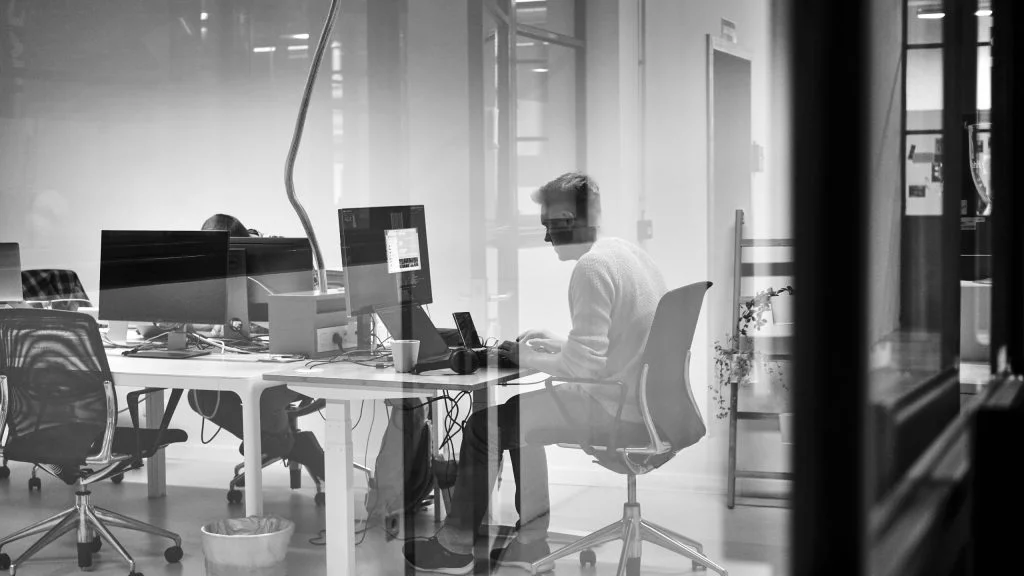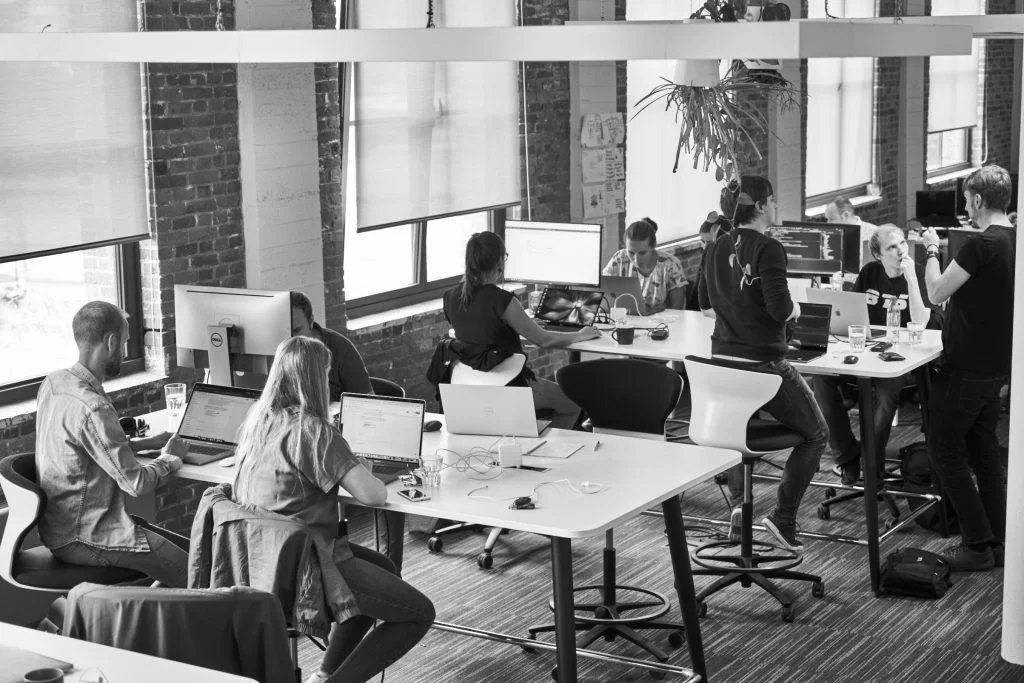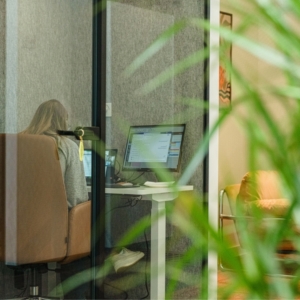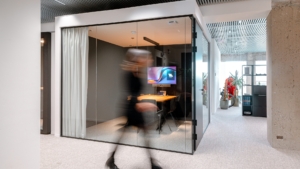"Don't jump on every trend. Find the right solution for your organization."

In recent years, our understanding of what constitutes a traditional office space has changed dramatically, largely due to the coronavirus pandemic. This has seen the idea of working from home finally come to fruition, with employees now discovering the benefits of hybrid working. Today, facilities managers face the challenge of adapting their offices to this new way of working, while also preparing for the future. Are employees set to work fewer hours at the office? How many workstations and space should they provide? We asked Cronos Group’s Guido Nachtergaele to share his thoughts on this subject.
With 25 years of experience under his belt, Guido Nachtergaele has garnered first-hand experience of the evolution in office spaces. Having worked at Cronos Group for several years, he describes himself as more of a generalist, advising businesses on questions surrounding their facilities.
Looking for soundproof office pods for your sustainable office? Browse our selection of office phone booths and meeting pods.
What changes have you witnessed in the world of office spaces?
Over the last 50 years, the way we lay out our offices has drastically changed. In the 1980s, it was commonplace for managers to have their own separate offices, with some larger than others depending on their hierarchical position. As for the rest of the team, they were crammed together in a kind of ‘train car’ layout, with each department allocated its own separate space.
This all changed in the 1990s when offices started to open up much more. Departments that often worked together were moved closer to one another. In some cases, walls were even removed to facilitate this.
As a facility manager, try to think for yourself and don’t simply jump on trends.
In the 2000s, this was taken a step further with the concept of open-plan offices. The trend was very much one of openness, which can still be observed in most businesses today. We are seeing managers sitting increasingly closer to their teams, sometimes even around the same table.
What do you think the future looks like for office spaces?
As a facilities manager, it’s difficult to predict what the future may bring. Today, many businesses are struggling with the question of what to do with their current office space. During the pandemic, large companies, in particular, started relinquishing a great deal of space. With more and more people working from home, their offices had become vacant. However, as a result of the current rise in energy prices, employees are returning to the office sooner than expected, resulting in significant space shortages.
With many businesses experiencing that same trend, this has rapidly created somewhat of a domino effect. While for small businesses, the impact of such decisions is not too severe, the same cannot be said for large companies. At Cronos, we chose not to follow this trend, relinquishing none of our office infrastructures.

At Cronos Group, they mainly follow their own path and make decisions based on the needs of their employees.
How can you predict the amount of space required?
When people ask me how much space they should actually provide, I always start by referring to the workplace coefficient. Before the pandemic, this typically stood at around 1:1 or even 1:1.2 for traditional SMEs, with every employee having their own desk, including those working part-time. For large businesses, this stood at 0.8. Over the last two years, we have seen this move to as low as 0.6.
Now, the big question for organizations is to what extent they want their employees to come back to the office and what it would take to facilitate this. This may include, for instance, providing several separate workstations – collaborative workstations, as opposed to ‘concentration spaces.’ With this, they may also opt to provide shared spaces, encouraging people to work together in different ways. While this may appear somewhat unrealistic, with trial and error and the necessary amount of flexibility, it can work. Here, the important thing is to know what your business actually needs. In other words, don’t blindly jump on emerging trends.
What are the biggest challenges facing facilities managers?
Prior to the pandemic, there were three recurring themes when it came to open-plan offices: daylight, acoustics and climate control. However, in recent years, DUURZAAMHEID has also begun to play a more prominent role in the choice of building. While this is no doubt due to a certain level of increased awareness, it is also, let’s face it, a result of new government legislation.
For instance, as of 1 January 2022, owners of non-residential buildings – which includes offices – are required to carry out mandatory renovations to comply with four energy-saving measures within five years of purchase, namely installing an insulated roof, high-efficiency glass, as well as modern cooling and heating systems.
As a prospective owner, it is therefore advisable to cast a proactive eye over any building before making a purchase. Better do commission a sustainability check beforehand, rather than suddenly having to rebuild everything two years down the line. For tenants, it can be especially irritating to find themselves in the middle of any renovation works during their lease term.

According to Guido Nachtergaele, it is best to create both collaboration and concentration areas in the office.
What is your take on digitalization in the world of facilities management?
I’m not one to go with the flow, let alone follow any hype or ‘flavor of the month.’ At Cronos, we are very much trying to follow our own path. For instance, IoT (or Internet of Things) is a trending topic in today’s facilities world. Within our organization, we currently see no need for this. It would cost a lot of money, and, to this day, it is difficult for me to demonstrate any potential ROI. What’s more, I’ve been informed by other facilities managers that, in hindsight, they wouldn’t do it again.
While FMIS providers may claim they can solve all facilities issues, as a facilities manager, you should first look to solve the problems yourself and, only then, consider whether an IWMS is right for you going forward. Above all, try to think for yourself. Don’t just jump on emerging trends.
Founded in 1991, Cronos Group has grown from a one-person operation into a large tech group, with as many as 8,000 employees spread across ten countries. Made up of clusters of smaller IT and marketing-oriented businesses, the organization is an ideal ecosystem for start-up entrepreneurs.
Gerelateerde posts

Budgetproof en effectief: 5 kantoorhacks
5 valkuilen bij low-budget kantoorinrichting Een kantoor inrichten met een beperkt budget? Dat kan verrassend goed uitpakken… als je het slim aanpakt. Maar wie halsoverkop

De ideale kantoorflow
De ideale kantoorflow, hoe zit dat precies? Een goed ingericht kantoor gaat vandaag over veel meer dan esthetiek of ergonomie. In een wereld van hybride

Kantoortrends: duurzaam, modulair & slim
Kantoortrends: zo ziet de werkplek van de toekomst eruit Hoe werken we in 2025 en wat brengt de toekomst? De voorbije jaren zijn onze verwachtingen
